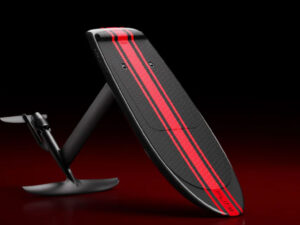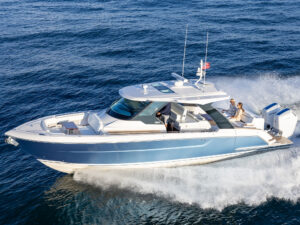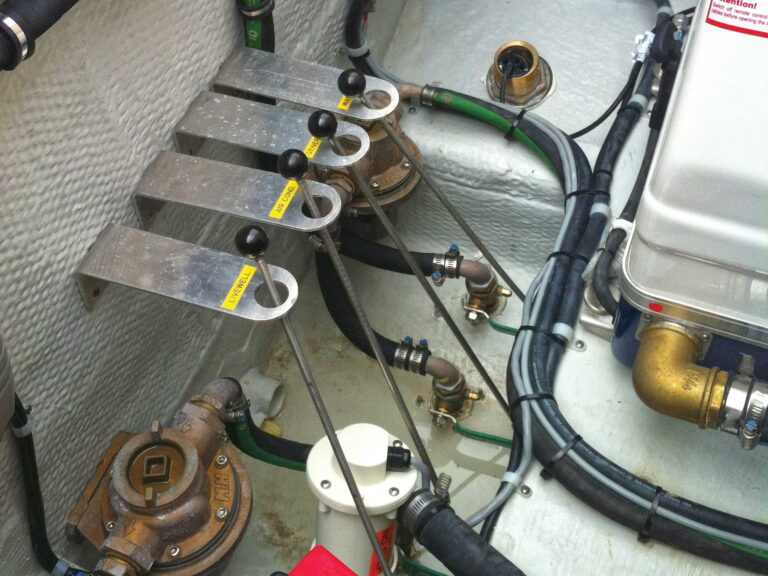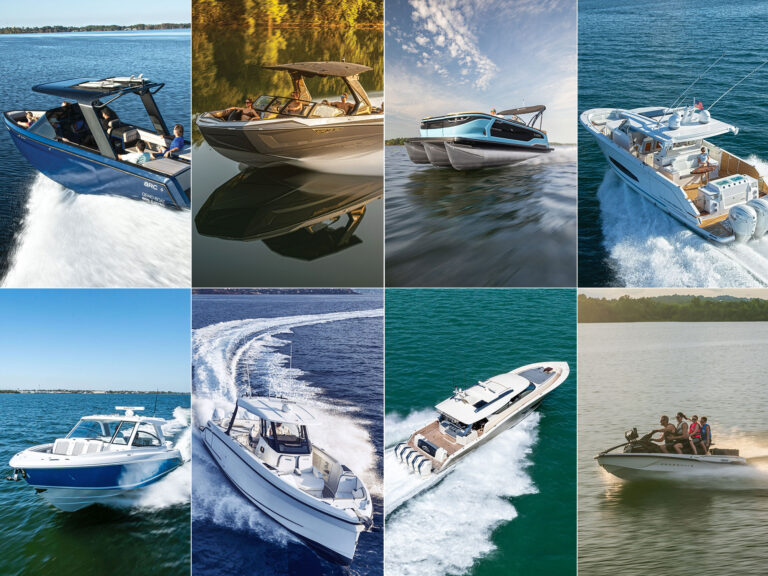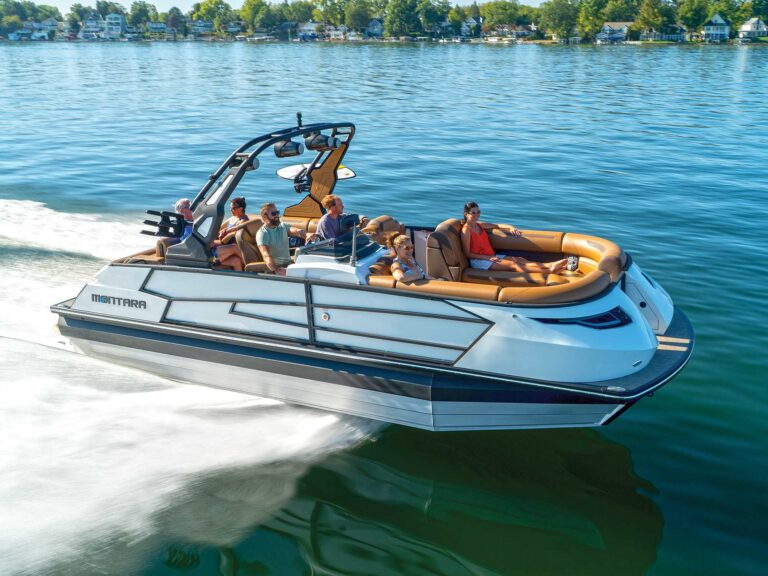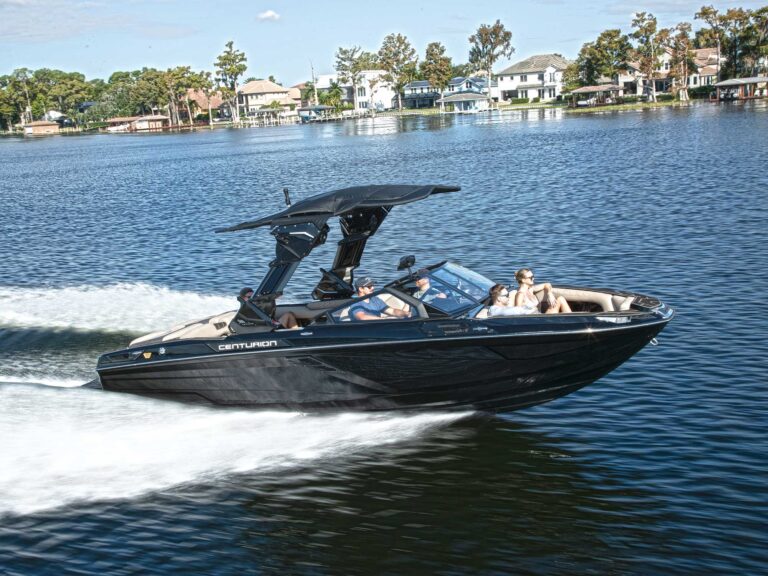Did you know that improper boat trailer tire inflation can reduce the load-carrying ability of your boat trailer? What about safety and how does boat trailer tire inflation play into that? Boat-trailer tires require a lot of air pressure — in most cases, between 50 and 65 psi — and having the wrong tire pressure increases your chances of a blowout or other performance issues while towing. Proper inflation of boat trailer tires affects many aspects of towing a boat and this article will drive home the importance of learning about how to find and maintain proper trailer tire pressure.
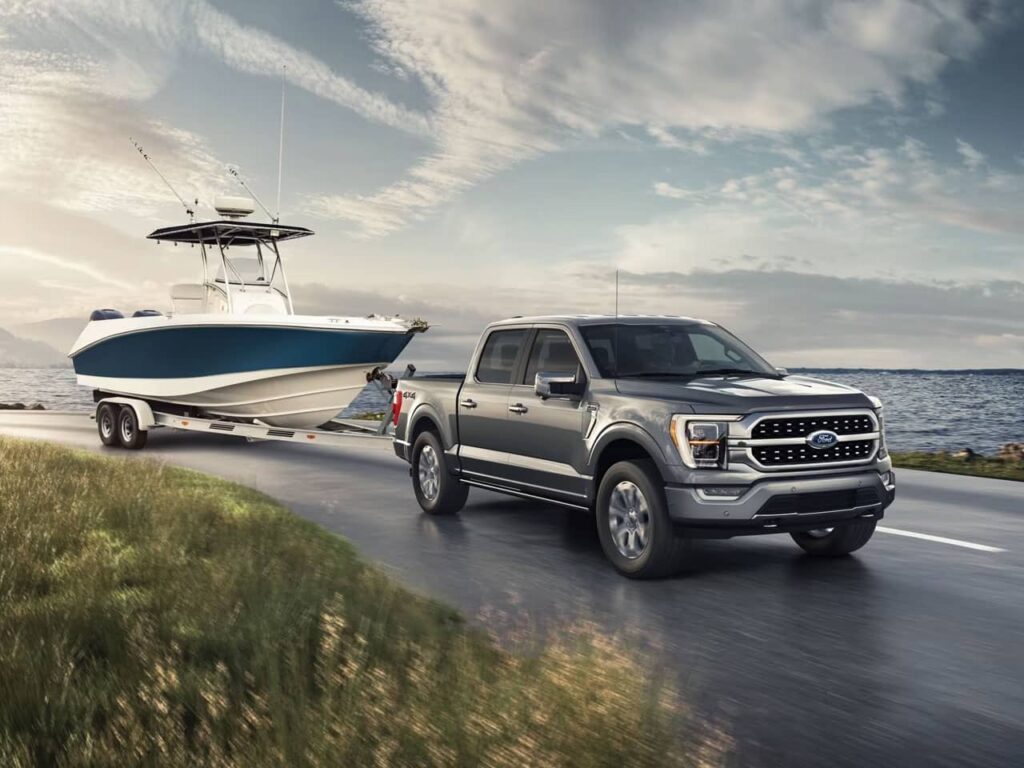
Article at a Glance:
- Reduced trailer tire pressure reduces the carrying capacity of your boat trailer.
- Improperly inflated boat trailer tires put you, and others on the road, in danger.
- Read and understand the writing and symbols on your boat trailer tire sidewalls.
What is the PSI for Boat Trailer Tires & Where to Find it
Boat trailer tires come in all different sizes and weight ratings. One thing is the same: trailer tires are properly inflated to higher pressures than many automobiles, SUV and pickup trucks, which often run on tires inflated to 35 psi. (Though large heavy-duty pickups will run on tires with higher inflation pressure.) Even many small trailer tires need to be inflated to 60 p.si., for example. But, just because the small trailer tire may be sized like a small car tire, it may require higher inflation pressure.
You can find the proper inflation pressure, in PSI, embossed on the sidewall of the tire. Another place to look is on the spec sheet for the tires in a brochure or website. Your tire or boat trailer retailer or tire manufacturer will also have this information. Find it and stick to it. Forget about bad advice to lower the air pressure to soften the ride or to account for the tire heating up on the road. The tire engineers already accounted for those things. If you purchase a new trailer, the tire information will also be on a sticker, often placed on or near the trailer tongue.
Trailer Tire Pressure Charts
All new trailers are supposed to have a VIN sticker or a tire-and-load sticker — often hard to find on an inside frame rail — that states the trailer-tire size, the GVWR (gross vehicle weight rating) with those tires, and the specified tire inflation in psi. If you are buying a used trailer, that sticker has likely long since faded away to nothing. Take the model number of the trailer from the registration to the trailer maker and ask for the specs. Then, make sure the tires are the correct size and rating. They may have been replaced with a less-expensive tire with an inadequate rating. If you can convince the seller of a used trailer to allow you the time to do this, you will be one savvy boat trailer buyer.
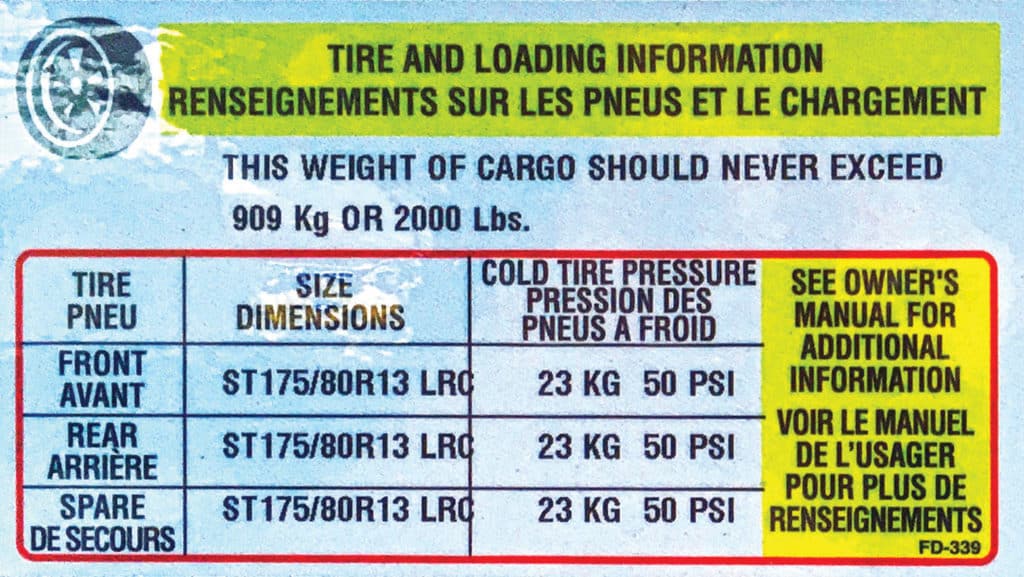
Tire Sidewall
A tire can be broken down into two major components: tread and sidewall. The tread is what contacts the road. The sidewall is the part between the tread and the wheel. It is on the sidewall where you will find embossed wording: tire pressure in psi and kpa (kilopascals, the metric unit of pressure) the Load Range, width, tire type and more things important to know about the tire. Use an air-pressure gauge–practice and become familiar with it if you have not used one before–and make sure the tires are inflated to the pressure stamped on the sidewall. A digital tire pressure gauge can be easier to use and read for many people. These are available from the same place you purchase boat trailer tires and other equipment.
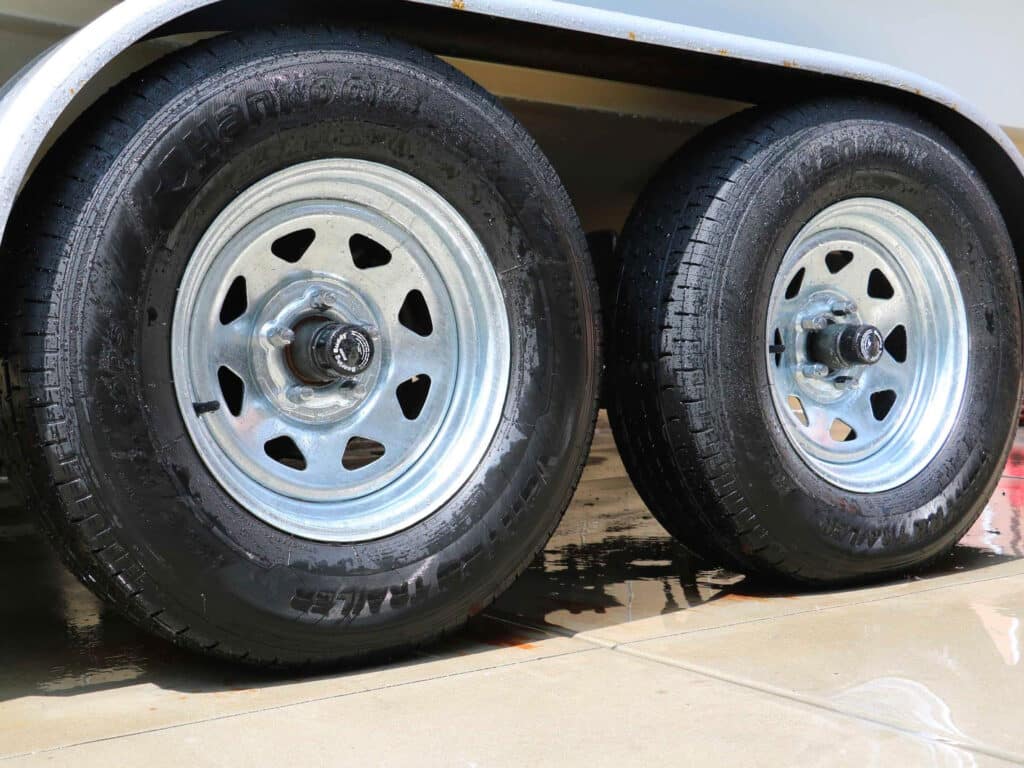
– TOW LIKE A PRO –
Safety Tip Provided by the U.S. Coast Guard
Remember to leave extra stopping room when trailering your boat. At the ramp, be considerate of others but take the time you need to launch and recover your boat safely. Always check tie-downs, safety chains, lights – and the drain plug.
The Importance of Proper Boat Trailer Tire Pressure
Tire Pressure determines the load the tire can safely carry. The load capacity of the trailer was determined with that specific tire pressure as a factor. If you roll out of the driveway towing your boat with less than the max psi in the trailer tires, you have effectively reduced the load capacity of the entire trailer. Underinflated and thus overloaded tires are the leading cause of trailer-tire failure; the tires overheat and fall apart.
Over-Inflated Tires Implications:
Over-inflation of boat trailer tires can lead to severe safety and handling problems.
- Overinflation can cause it to burst, causing personal injury while filling the tire with air. Always check tire pressure before and during inflation.
- Overinflated tires change the shape of the tread, which can cause loss of traction and thus increase the chances for slipping and sliding.
- An overinflated boat trailer tire is much more likely to blow out. A blowout not only delays getting to the water, it risks handling anomalies that could cause loss of control of the rig, and, possibly, an accident.
Under-Inflated Tires Implications:
Under-inflating boat trailer tires is just as bad as overinflating them, as far as its bad effects on safety and handling goes.
- Increased friction of under-inflated boat trailer tires leads to increased heat and increased chance of a blowout. A blowout can cause loss of control and an accident. At the least, it will delay your trip while you sweat ( and swear) by the side of the road.
- Poor fuel economy as the misshapen tire increases rolling drag results from under-inflated boat trailer tires.
- Faster breakdown of the tread results from tires that are underinflated. This costs more money since you will replace the tires more frequently.
How Load Capacity Relates to Trailer Tire PSI
The carrying capacity of your boat’s trailer hinges upon proper tire pressure. Reducing the tire pressure by 20 percent say, from 50 psi to 40 psi, will reduce the tires’ load rating by about 12 percent. So, if you have a 3500-pound boat on a trailer rated for 4100 pounds, you are suddenly right up against the limit. Since you probably have gear and supplies in your boat, you may even exceed the trailer’s load rating.
Here’s an example:
A single-axle boat trailer with a 2,490-pound GVWR (trailer plus cargo) rolls on ST175/80R13C tires with a max trailer tire PSI of 50 pounds.
- At 50 psi, each tire is rated to carry 1,360 pounds, or a combined 2,720 pounds for the pair of tires.
- If the tire pressure is reduced to 40 psi, the individual tire-load rating drops to 1,190 pounds (2,380 pounds combined), or 110 pounds less than the trailer capacity.
- If you are in the habit of airing those trailer tires to just 35 pounds ( because your truck tires run at that inflation) the combined tire capacity drops to just 2,200 pounds. This could be a problem if the boat (including outboard, batteries, fuel, and gear) plus the trailer weighs 2,400 pounds.
How to Determine Load Size & Capacity
A new trailer will have a capacity plate. This is usually just a sticker that fades away faster than a falling tide. Don’t expect to find one on a used trailer: ask the manufacturer for the info. At any rate, on this plate or sticker, you will find the Max Capacity, Gross Vehicle Weight Rating (GVWR), and Gross Axle Weight Rating (GAWR) for a given tire size and inflation pressure.
- Max. Capacity: The GVWR minus the weight of the trailer itself. This is the maximum weight you can load on the trailer and includes not only the boat but the fuel (@6-lb per gallon) and gear in the boat. Very important point.
- GVWR: The Gross Vehicle Weight Rating is found by multiplying the GAWR (Gross Axle Weight Rating) by the number of axles. A single-axle trailer’s GVWR and GAWR are the same.
- GAWR: The Gross Axle Weight Rating is the weight rating for each axle.
- Trailer Weight: Subtract the Max Capacity from the GVWR
- Tire Pressure: This is listed as all other capacities depend upon it. This is given as “Cold Inflation Pressure”. Cold inflation pressure is measured before the tire has been on the road and is assumed to be 68 degrees F. Always inflate tires to the rated cold inflation pressure.
– SHOW THEM HOW MUCH YOU CARE –
Safety Tip Provided by the U.S. Coast Guard
Nothing says ‘I love you’ like making sure the kids’ life jackets are snugged up and properly buckled.
Signs of Improper Trailer Tire Pressure
Trailer tire inflation should be checked with a gauge every time you use the trailer or every two weeks if you are not using it. You cannot readily detect most levels of improper inflation by eye. Use a quality tire gauge to check the trailer tire inflation pressure. If the tire is overinflated, depress the center pin of the Schrader inflation valve.(Usually, air pressure gauges have a pin or button built-in for this purpose) If the tire is underinflated, apply the air pump hose to the Schraeder valve securely and add air in spurts, stopping to check with your gauge as you go. Experience will soon show you how to do this with economy of motion.
Checking the tire pressure is also a good time to make a visual inspection of the tires. Check the sidewalls for cracks that indicate dry rot (most trailer tires die of rot, not mileage). There are also wear indicators on the tire. Naturally, deep scratches, gouges, or visible cuts should be treated as serious and given attention. Also, check the wheel rim–where the tire meets the wheel- for dents and damage that can cause annoying and persistent slow leaks.
Finally, don’t forget to inspect your trailer’s spare tire for all of the above! Too many trailer boaters neglect the spare!

Common Sources for Low Tire Pressure
- Not Checking: The number one reason for low boat trailer tire inflation pressure is the failure of the owner to regularly check the pressure.
- Faulty Valve Stem: Tires can lose pressure through the valve stem if it is faulty. These are cheap and easy to replace as a DIY project.
- Damaged Wheel Rim: Damage to the wheel rim can cause air leaks. If you rub against a curb, your wheel rim may be damaged. Most boaters let pros fix damaged wheel rims.
– ALWAYS USE YOUR ENGINE CUT-OFF LANYARD –
Safety Tip Provided by the U.S. Coast Guard
Make sure your Engine Cut-Off Switch lanyard is attached to your person whenever you’re underway. They’re now required on all open boats under 26 feet.
Closing Remarks & FAQs
There are more reasons for boaters to check for proper boat trailer tire inflation than you can shake an air pressure gauge at!
Should boat trailer tires be inflated to max psi?
Yes, boat trailer tires should be inflated to the pressure embossed on the sidewall. Ask any tire retailer or check the website of any tire maker, such as automotive.kendatire.com/en-us/tire-tech/tire-101/ to confirm this.
Why is trailer tire PSI so high?
Trailer tire pressure is so high because they are constructed using heavier-duty sidewalls and are intended to bear greater loads than most vehicle tires. Again, tire makers and reputable retailers are all in agreement on this. Here is an example: hendrickson-intl.com/getattachment/ac8c825c-b799-4a87-bac0-f75f746c747c/TMX_WhitePaper.pdf
What load range should boat trailer tires be?
Most trailer tires are load range B, C, or D. The main thing is boat trailer tires should be of a load range each that adds up to the GVWR of the trailer. Check the trailer’s capacity plate ( or make/ model paperwork specs to confirm.)
What types of tires are available for trailers?
Trailer tires should have the designation ST molded in on the sidewall. This means “ special trailer” and indicates the different construction and rating compared to a vehicle tire. See: tireindustry.org/resources/consumer-education/consumer-safety-overview/reading-a-tire-sidewall/
What tools do you need or make it easy to check PSI?
The tools to check trailer tire inflation pressure are a tire gauge and a good set of eyes to read it.
Can you air up trailer tires while loaded?
Yes, you can! Despite urban legends, the tire air pressure is not increased under load. Put another way, the shape of the tire might be different under load but the volume remains the same.
What is the best way to keep tires properly inflated?
Vigilant maintenance in checking tire pressure is the best way. You can purchase sensors that connect to a smartphone and will give you “live” readings of your boat trailer’s tires.
How often should boat trailer tire inflation be checked?
Boat trailer tire inflation psi should be checked every time you use the trailer.


